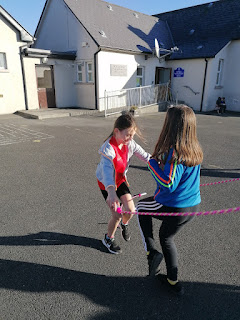Learning to Skip
Children learn to jump before they can hop or skip. Skipping is a difficult skill to learn. It involves the legs and arms performing
different tasks at the same time. Rhythm
and timing are extremely important. Some
children find it easier to learn to skip on the spot while others find it
easier to learn to skip on the move (e.g. like they are walking).
Below are some activities you can try. Try to do them in the order that they are
presented in as this will make it easier, but if your child easily achieves one
task, move onto the next one.
Activity Ideas
Before you can learn to skip they need to be able to:
- Jump/hop over a rope laid on the floor.
- You need to be able to hold and turn the rope without worrying about jumping.
- Jump on the spot 10 times or hop from one foot to the other staying in the same place 10 times.
- Move your arms and legs at the same time e.g. doing star jumps.
- Time your jump/hop – can you jump/hop in time with the beat? Use music with a strong beat.
Practice each of these steps individually before trying to
co-ordinate them.
Make sure you have more than enough space to swing the rope.
You should start with the rope held in both hands so that it
touches the ground behind you. Lift your
arms so the rope lifts up and swings against your legs. Do this 5-10 times.
Bring the rope up over your head so that it lands in front
of you.
Once you can do this you can start to jump or step over the
rope. Go really slowly. Wait for the rope to stop before you jump or
step over it.
Once you have mastered the process you can start to speed
up. They could try skipping to music to
help them establish a rhythm.
Extra Challenges
Once you can skip you could try the following activities:
- How many skips can they do in a row? Count them, and then see if you can beat their record the next time.
- See how many skips you can do in two minutes.
- Try skipping and moving at the same time or skipping on the spot (depending on how you learnt to skip).
- Skipping round obstacles.
- Race with a friend.
- Can they do any tricks? Skipping backwards, crossing the rope.









Comments
Post a Comment